[back] Auschwitz-Birkenau [back] Holocaust revisionism
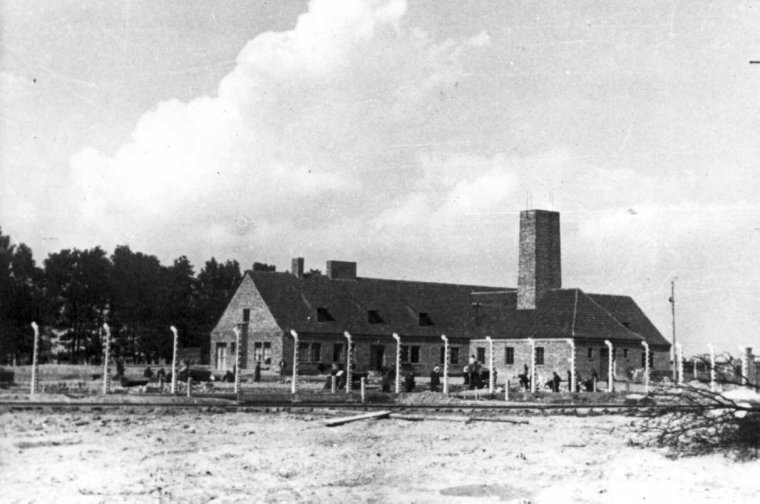
Birkenau 'gas chambers' (Kremas
II-V)
[back] Auschwitz-Birkenau
[back]
Holocaust
revisionism
[Convenient these were blown up. These are underground
morgues. There are no holes in the roof for putting in Zyklon B (see
holes). You have to swallow these absurdities:
that the Germans would make gas chambers out of morgues (how's that for forward
planning of the 'Final Solution'?), that 1-2,000 people would
just walk to their death, and cram in at 4-10 people per square yard,
1,2 that
it took only 20 minutes, while the building was in full view (see picture) of
anyone outside the camp and a kitchen 50 metres away, and to get the required
temperature to activate Zyklon B they used 'open coke containers'! 1
Then there is no blue
staining from Zyklon B as there is in the
Birkenau delousing buildings, with no vent pipes visible from air photographs.
Two of the crematorium architects were acquitted---The report concluded
that the rooms in question could not have been gas chambers, nor could they have
been converted into gas chambers in the
1972 Vienna Auschwitz trial.
See Gas chambers (real).
With the 46 retorts of the crematories it would only
have been possible to cremate the number of people who died
due to natural causes, as recorded in camp documents (from 1939 and 1945
around 150,000 people), also shown by the amount
of fuel ordered.
1
Lagace And aerial shots show no coal
transportation system of any kind and not enough coke to
cremate more than 100 corpses a day
1.
Rudolf Hoess,
Filip Mueller,
Rudolf Vrba &
Olga Lengyel are typical 'eye witnesses'
for gas chambers,
Tijudar Rudolph,
Judge Wilhelm Stäglich,
Thies Christophersen &
Joseph G. Burg against.]
See: Auschwitz 'gas chamber' (Auschwitz I) Gas chambers (real) Gas chambers (large) Fake Nazi 'gas chamber' at Sachsenhausen
Convergence or Divergence?: Recent Evidence for Zyklon Induction Holes at Birkenau Crematory II
[2001] A Brief History of Forensic Examinations of Auschwitz by Germar Rudolf
Photographs of Birkenau's Krema II, Morgue I (1993)
[Kenneth R. Wilson] The 'False News' Trial of Ernst Zündel -- 1988
BIRKENAU -- KREMAS II, III, IV AND V
Samuel Crowell. The Basement Showers of Crematorium III, (March/April 2001), vol. 20, no. 2: p. 17.
New Document Sheds Light on Irving's Interpretation of Auschwitz
Quotes
One must ask how, for example in the case of Auschwitz II or Birkenau, one could
bring 2,000 people into a room measuring 210 square meters in area, and then in
this highly crowded situation throw in the very strong pesticide Zyklon B, and
then immediately after the deaths of the victims let a work crew without
any gas masks enter the room in order to take out the bodies which had been
thoroughly saturated with cyanide.
Two documents from the German industrial archives which
were registered by the Americans at Nuremberg tell us that the Zyklon B had a
strong tendency to adhere to surfaces and could not be removed from an ordinary
room with a strong ventilator, but only by natural aeration for almost 24 hours.
Additional documents may be found only at the site in the
Auschwitz Museum archives, which were never described elsewhere, but which show
that this room of 210 square meters, which is today in a dilapidated condition,
was only a very simple mortuary, which (in order to protect it against heat) had
been located underground, and which was provided with only a single door which
served as both an entrance and an exit. [2005] The
Problem of the Gas Chambers By Robert Faurisson 2005
In Leuchter's opinion, the facility did not indicate even reasonable gas chamber design, it being identical to Krema II. It was not tarred or pitched. There was no ventilation. It was cold and damp. It had no means of introducing the Zyklon B material. (32-9093) Nowhere did he see any blue staining. (32-9195) [Fred A. Leuchter] The 'False News' Trial of Ernst Zündel -- 1988
Krema IV was allegedly destroyed during a mutiny of prisoners on October 7, 1944. (19-4447) As with many other things concerning the camp, the Auschwitz officials were not forthcoming with information concerning these buildings. (19-4446) [Ditlieb Felderer] The 'False News' Trial of Ernst Zündel -- 1988
Ken Wilson, a specialist in aerial photographs, had shown that the homicidal "gas chambers" of Auschwitz and Birkenau did not have gas evacuation chimneys, which would have been indispensible. He also showed that I had been right in accusing Serge Klarsfeld and Jean-Claude Pressac of falsifying the map of Birkenau in the Auschwitz Album (Seuil Publishers, 1983, p. 42). Those authors, in order to make the reader believe that groups of Jewish women and children surprised by the photographer between crematories II and III could not go any farther and were thus going to end up in the "gas chambers" and those crematories, had simply eliminated from the map the path which. in reality led up to the "Zentralsauna," a large shower facility (located beyond the zone of the crematories), where those women and children were actually going. The Zündel Trials (1985 and 1988) by ROBERT FAURISSON
Between January 18 and March 10, 1972, two architects responsible for the design and construction of the crematoria in Auschwitz-Birkenau, Walter Dejaco and Fritz Ertl, were put on trial in Vienna, Austria.11 During the trial, an expert report on the possible interpretation of the blueprints of the alleged gas chambers of the Auschwitz and Birkenau crematoria was presented to the court. The report concluded that the rooms in question could not have been gas chambers, nor could they have been converted into gas chambers.12 Thanks to this first methodologically sound expert report on Auschwitz, the defendants were acquitted. [2001] A Brief History of Forensic Examinations of Auschwitz by Germar Rudolf
On August 16, 1991, while standing on the collapsed roof of the alleged "gas chamber" of crematorium II in Birkenau, I lost my faith in the "Holocaust," because I could find no holes that deserved the name. [2001] A Brief History of Forensic Examinations of Auschwitz by Germar Rudolf
40 tons of coal/day, at 30 kg (66 lbs) of coal/body, would have been needed to cremate 1,400 bodies a day. Had no coal piles or storage yards next to the rail lines (1) or in yards (2) next to cremation buildings. Had no coal transportation system of any kind.--11 'Eye-Witness' Stories Contradicted by Air Photos
Four dots on the drawing of Krema II (Exhibit 136) indicated where vents were supposedly located on the roof of the building wing normally designated as the gas chamber. After an examination of the roof, from both inside and outside, Leuchter found no holes in these locations. (32-9080, 9081) [Fred A. Leuchter] The 'False News' Trial of Ernst Zündel -- 1988
In 1945 the Allies should have asked specialists on American gas chambers to examine the buildings, at Auschwitz and elsewhere, which were supposed to have been used to gas millions of people. Since 1977, I have had the following idea: when one deals with a vast historical problem like that of the reality or the legend of the Holocaust, one must strive to get to the core of the problem; In this case the central problem is Auschwitz and the core of that problem is a space of 275 square meters: the 65 square meters of the "gas chamber" of crematorium I at Auschwitz and, at Birkenau, the 210 square meters of the "gas chamber" of crematorium II. In 1988, my idea remained the same: let us have expert studies of those 275 square meters and we will have an answer to the vast problem of the Holocaust! I showed the jury my photos of the gas chamber at the Maryland State Penitentiary in Baltimore as well as my plans for the Auschwitz gas chambers and I underlined the physical and chemical impossibilities of the latter ones. The Zündel Trials (1985 and 1988) by ROBERT FAURISSON
Felderer was certain that the buildings marked on plans of Auschwitz as
crematories (called Kremas) were indeed used as such.
He did not believe they were used as gas chambers. (19- 4374) Auschwitz-Birkenau
needed crematories because the camps were engulfed by extreme epidemics of
typhus, caused primarily by lice. Epidemics were so severe that at times the
authorities prohibited people from entering Auschwitz or the surrounding area
for a radius of some 40 km. in efforts to contain the disease. For the same
reason, it was necessary to dispose of the corpses by cremation. (19-4409, 4410)
The crematories were built at the same end of the camps as the sewage plants and
water purification plants. (19-4433, 4434)
Krema II at Birkenau contained five furnaces with three retorts each. The
rooms below ground alleged to be gas chambers were shown as morgues on the
original blueprints obtained by Felderer from Auschwitz officials. They required
cool places to store the corpses, thus the rooms were below ground. (19-4409)
The Auschwitz Museum stated that the victims would go down the stairs into
the undressing room, undress and wait their turn to be gassed. The actual
gassings were alleged to have taken place in an adjoining room. The Zyklon B was
said to have been discharged into the gas chamber through seven holes in the
roof. After the gassing, the victims were allegedly taken up to the crematory
and burned.
Felderer testified that he told Zündel there were two major problems with
this account: first, the crematories at Auschwitz were not much different from
those still used in Sweden which took an hour and a half to two hours to
incinerate a body. This meant that the bodies of the allegedly gassed would have
piled up considerably since the furnaces would not have been able to handle the
volume. Secondly, since Zyklon B was so dangerous to handle, it would have meant
that the entire staff of the building and those waiting to be gassed would have
been gassed in any event. Felderer found the whole theory "ridiculous."
(19-4421, 4422)
Felderer examined and measured the roof over the alleged gas chamber at Krema
II. He found only a natural crack and two holes chiselled into the concrete with
twisted reinforced steel sticking out. Neither hole was in the position on the
roof that the Auschwitz authorities alleged they should have been. A heavy
concrete lid lying by one of the holes did not fit. Felderer believed the holes
were chiselled out after the war to support the gassing allegation. (19-4423,
4424) The alleged gas chamber was 70 metres long, 30 metres wide and 2 metres 20
cm. high. (19- 4479)
Inside the alleged gas chamber of Krema II, Felderer found and photographed
drains on the floor. Extermination authors such as Reitlinger claimed that the
gas chamber had no drainage. (19-4425) There was no evidence on the inside of
the alleged gas chamber of the bluish stain characteristic of Zyklon B. Nor was
there any evidence of facilities for the shower heads which extermination
literature also claimed were used for the discharge of the gas. The pillars in
the room were of solid concrete; this contradicted extermination stories of
hollow pillars down which the Zyklon B was allegedly thrown.(19-4426, 4427)
Felderer found no evidence of an opening for ventilation to exhaust the gas.
(19-4477) Neither Krema II nor III, upon examination by Felderer, showed any
indication of the blue stain associated with Zyklon B. (19-4430)
Very little remained of Kremas IV and V, and Felderer was not convinced that
these buildings had, in fact, been used as crematories. He speculated that,
given the size of the camp, they might in fact have been garbage incinerators.
He pointed out that, given the severe typhus epidemics at the camp, the Germans
would not have taken the garbage out of the camp thereby risking the spread of
the disease. Felderer showed a slide of a wagon he found beside Krema IV which
looked very much like the wagons used in incinerators in Sweden to take away
ashes. (19- 4445, 4448) Krema IV was allegedly destroyed during a mutiny of
prisoners on October 7, 1944. (19-4447) As with many other things concerning the
camp, the Auschwitz officials were not forthcoming with information concerning
these buildings. (19-4446)
Felderer discussed with Zündel the problems which would have arisen in any
attempt to gas people in underground rooms such as the alleged gas chamber at
Krema II. There was the danger of explosion; the requirement of a tremendous
ventilation to get the gas out so that a new batch of victims could be put into
the room. He came to the conclusion that the building was never used as a gas
chamber, but was used as a crematory and morgue, as indicated on the original
German blueprints where the alleged gas chamber was labelled a Leichenkeller - a
place where corpses were stored. (19-4477 to 4480)
[Ditlieb Felderer]
The 'False News' Trial of Ernst Zündel -- 1988
Evidence that there were no vent holes in the roof of an alleged Birkenau gas chamber in 1944.
Close up of cremation buildings, go here for interactive numbers.
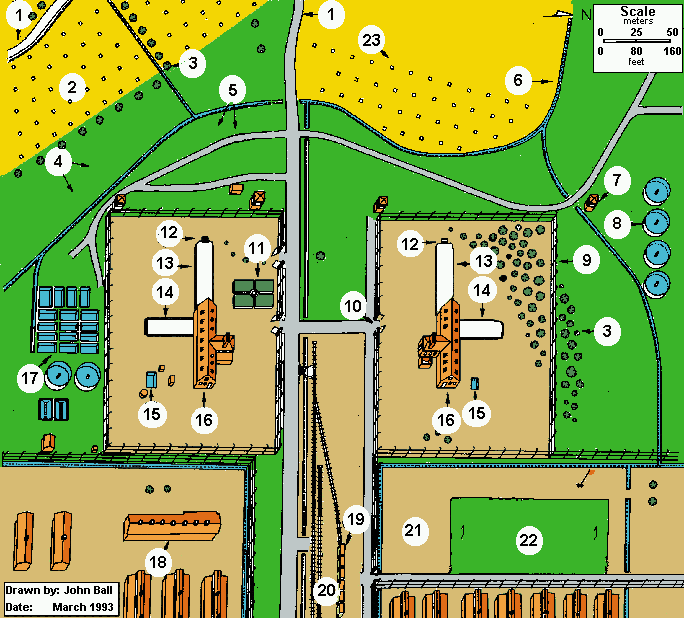
12


Hole # 2 (right hole): The hole was made by breaking the cement, most likely
with a large hammer, and cutting one end of 3 reinforcing iron rods with a
hack-saw before bending them. The hole measures 60 cm. X 50 cm. (2 ft. X 1 ft. 8
"). At this location the roof has collapsed to within 45 cm. (1 ft. 6") of the
broken cement lying on the ground. Had the dark hole existed in 1944, it would
have been visible in air photos, which it is not.
Right hole crudely
broken through cement roof
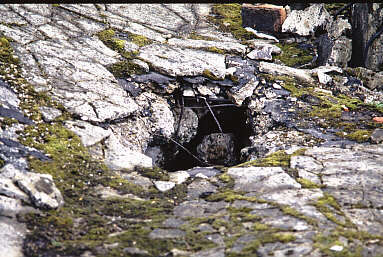
In 1943 the Germans would have cut straight edges and neatly trimmed the
reinforcing rods. This job appears to be the product of post-war Communists, not
war-time Germans.
Another view showing the jagged edges of the same hole

[See: Fredrick Töben.] It was alleged by important "eye-witnesses" who testified at post-war trials that cyanide pellets were dropped down hollow posts where gas then escaped into the room thorough wire-mesh-covered openings. This was also displayed on the large Auschwitz museum camp-model before it was removed in 1991. This is false as the posts are all solid cement. (photo: 1997) All posts are solid, not hollow
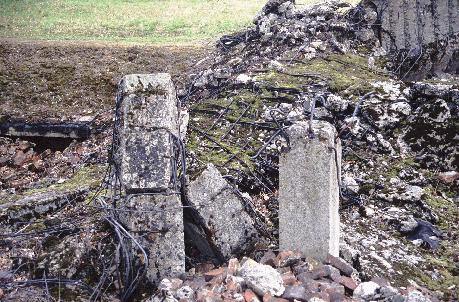
At No. 3 cremation building solid cement posts also protrude
through the collapsed roof again proving cyanide pellets could not have been
poured down hollow posts. (photo 1997)
All posts are solid, not
hollow
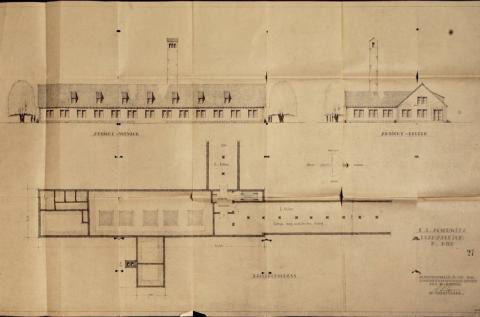
Blueprint of Krema II building, found in a Berlin apartment
On the blueprint shown above, the gas chamber is on the right. To the left of the gas chamber is the above-ground oven room with the ovens designated by 5 squares. The undressing room is perpendicular to the gas chamber. On the blueprint, the gas chamber is labeled L-keller which is an abbreviation for Leichenkeller, which means corpse cellar in English. The undressing room was also called a Leichenkeller on the blueprint. http://www.scrapbookpages.com/auschwitzscrapbook/tour/Birkenau/RuinsII01.html
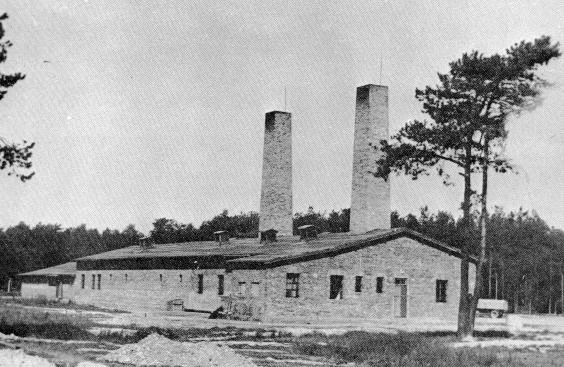
Krema 4
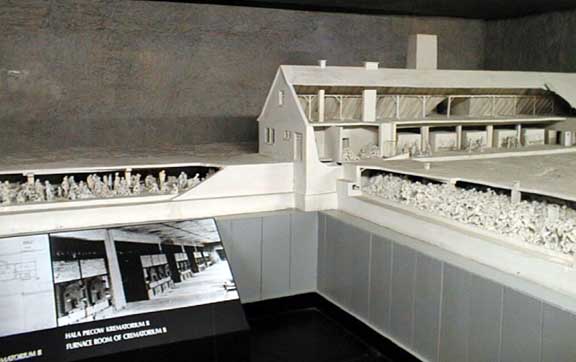
Scale model of Krema II at the US Holocaust Memorial Museum
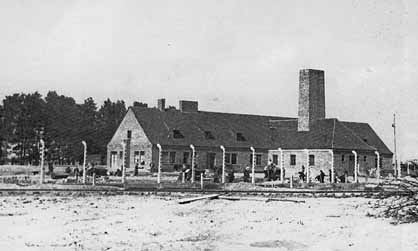
Crematorium III at Birkenau, as it looked in 1943
According to a book from the Auschwitz Museum, Crematorium III was blown up by the Nazis on Jan. 20, 1945, the same day that Crematorium II was destroyed. A book from the U.S. Holocaust Museum entitled "The World Must Know" by Michael Berenbaum says that "Soviet troops entered Birkenau on January 18, 1945."

Krema III
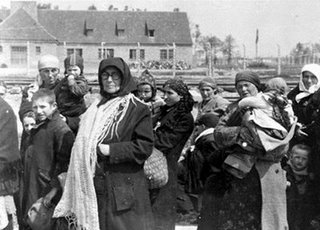
Krema III